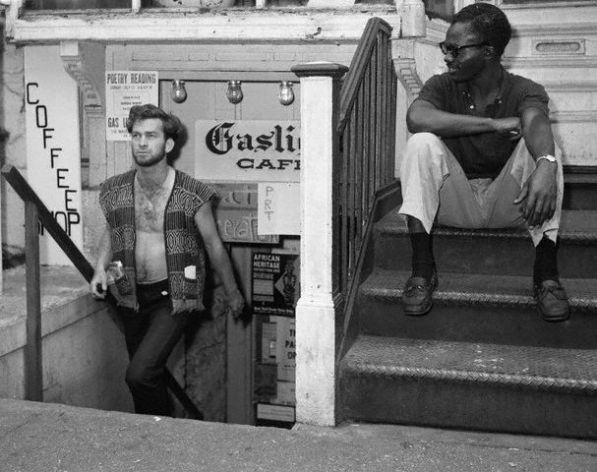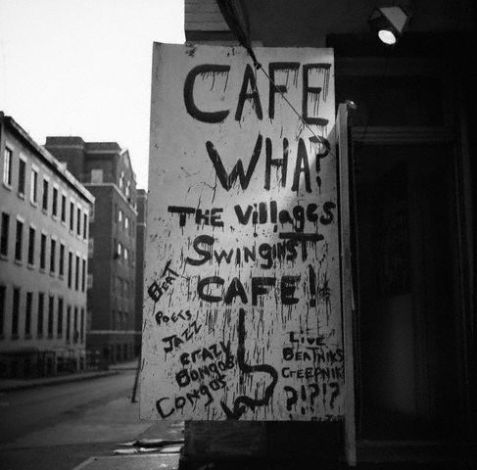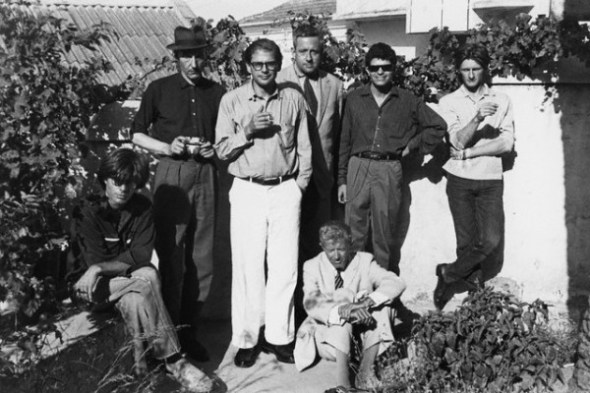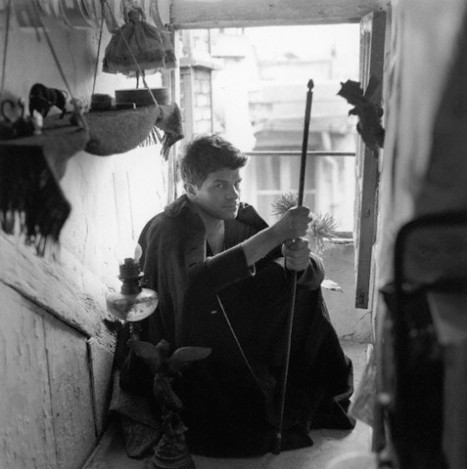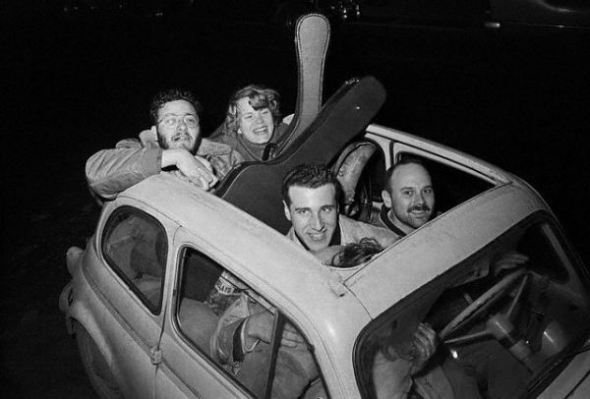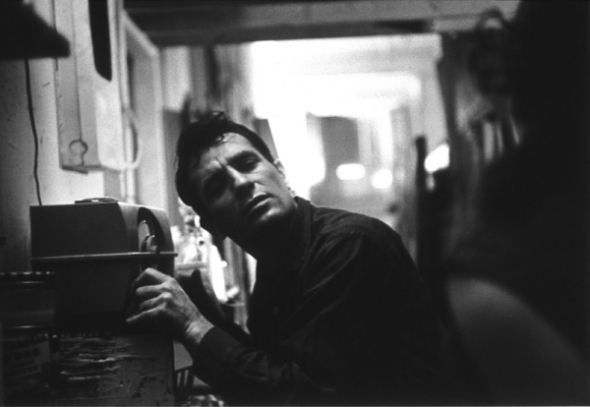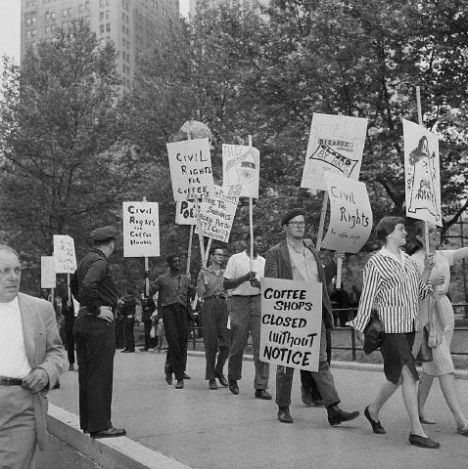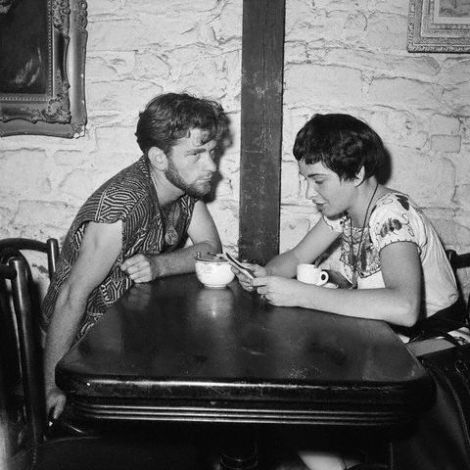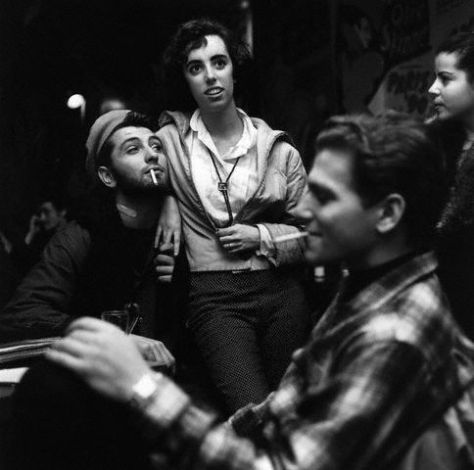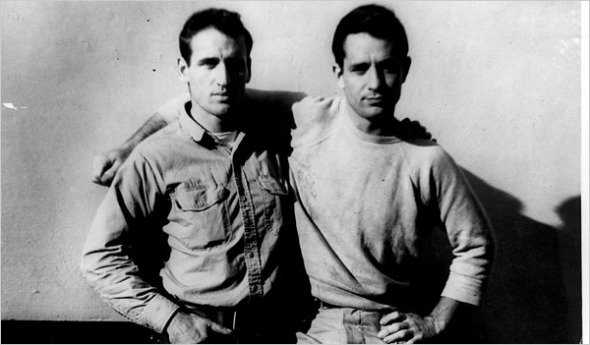The Beat Generation
by Vinyl Renewal
You’re sitting in a coffeehouse in New York – Greenwich Village to be precise. To your left sits a cup of what you hope will fuel a productive afternoon of writing, with the spread of papers, pens and books that adorn the small, round table. As the sun rears its head through the misty window, your senses are aroused by the plumes of smoke and rumblings of music, your ears prick to the excited conversation – it’s the 1950s and you’re part of something, something vaguely resembling a counter-culture revolution (or at least that’s what you like to think.) Throngs of dissidents, poets, artists, writers, social explorers fill the joint. Creative anarchists reacting against the ugly bloat of materialism induced by World War II, experiencing the mysticism of drugs to the Beat.
“Beat” was a condition, a radical removal from the mindless conformity fraught by consumerism. A common theme that linked them all together was a rejection of the prevailing American middle-class values, the purposelessness of modern society and the need for withdrawal and protest. In its advent in the late 1940s, a Beat Generation was generally centred in New York City and San Francisco, where it spun its web in Greenwich Village, North Beach, and the fringes of university neighbourhoods across the country. The Beat learned how to transform the lonely countryside as well as dismal flats in cities: otherness flowed in the movement’s veins. Wandering the pavements in Greenwich Village, to the San Remo all the way to the White Horse Tavern, you could smell change in the air.
The neighbourhood started life as a prosperous residential area during colonial times and had become a tenement district in the nineteenth century. However, artists and bohemians from across the country started to gravitate towards the village’s warm glow – not to mention the affordable rent for struggling artists. The Village provided ample opportunity for artists to express themselves, with an array of vaudeville theatres. One of the first venues was the Greenwich Village Follows, where dancers and musicians such as Martha Graham and Cole Porter started out. By the 1940s, the Village became an International meeting ground for writers spanning every genre.
Slipping into the 1950s, the Village had become the hub of musicians, poets and artists flocked to discuss and cultivate ideas. For example, two of the most prolific American movements set up home in Greenwich village: nearly all of the Abstract Expressionists, including Jackson Pollock and Mark Rothko lived in the neighbourhood. Similarly, the New York School of Poets was sharing the same bars, restaurants, and lofts. In the next decade, Greenich Village attracted the furthest stretches of diverse creative minds, including: composer John Cage, artists Robert Rauschenberg and Jasper Johns and dancers Merce Cunningham, to name a few.
Among its most influential members were Gary Sunder, the radical poet Allen Ginsberg, William Burroughs and Jack Kerouac. Kerouac was the acknowledged leader and spokesman for the Beat Generation. The major Beat writings include Jack Kerouac’s On the Road, Allen Ginsberg’s Howl, and William Burroughs’ Naked Lunch. Both Howl and Naked Lunch became the focus of obscenity trials in the United States that helped to liberalize what could be legally published.
Allen Ginsberg said some essential effects of Beat Generation artistic movement could be characterized in the following terms:
- Spiritual liberation, sexual “revolution” or “liberation,” i.e., gay liberation, somewhat catalyzing women’s liberation, black liberation, Gray Panther activism.
- Liberation of the word from censorship.
- Demystification and/or decriminalization of some laws against marijuana and other drugs.
- The evolution of rhythm and blues into rock and roll as a high art form, as evidenced by the Beatles, Bob Dylan, and other popular musicians influenced in the later fifties and sixties by Beat generation poets’ and writers’ works.
- The spread of ecological consciousness, emphasized early on by Gary Snyder and Michael McClure, the notion of a “Fresh Planet.”
- Opposition to the military-industrial machine civilization, as emphasized in writings of Burroughs, Huncke, Ginsberg, and Kerouac.
- Attention to what Kerouac called (after Spengler) a “second religiousness” developing within an advanced civilization.
- Return to an appreciation of idiosyncrasy as against state regimentation.
- Respect for land and indigenous peoples and creatures, as proclaimed by Kerouac in his slogan from On the Road ‘The Earth is an Indian thing.’
So, as you can see, the Beat generation provoked changes in artistic thought and creation and one of the most important changes was in music. Bob Dylan, The Beatles were heavily influenced by the Beat Generation. Members like Allen Ginsberg were influential in the anti-war movement. Others who were influenced include: Jefferson Airplane, Joan Baez, Country Joe and the Fish, Crosby Stills Nash and Young.
Joan Baez singing to Bob Dylan whilst he writes.
Joan and Bob duet
As the Beat Movement was getting underway, bebop was already going strong, especially in New York City, where 52nd Street was bustling with activity in jazz clubs up and down its length. Bebop was an innovative style of jazz which saw its heyday in the ’40s, characterized by smaller combos as opposed to big bands and a larger focus on virtuosity. Bebop’s renaissance came about in the heart of New York City, where musicians like Dizzy Gillespie, Thelonious Monk, Charlie Parker, Max Roach and Miles Davis were ushering in a new era for jazz music.
Jack Kerouac, Allen Ginsberg and and friends spent much of their time in New York clubs such as the Red Drum, Minton’s, the Open Door and other hangouts, shooting the breeze and digging the music. Charlie Parker, Dizzy Gillespie and Miles Davis rapidly became what Allen Ginsberg dubbed “Secret Heroes” to this group of aesthetes.
Dizzy Gillespie and Charlie Parker
“The word ‘beat’ was primarily in use after World War II by jazz musicians and hustlers as a slang term meaning down and out, or poor and exhausted”. Kerouac went on to twist the meaning of the term “beat” to serve his own purposes, explaining that it meant “beatitude, not beat up. You feel this. You feel it in a beat, in jazz real cool jazz”.
The Beat authors borrowed many other terms from the jazz slang of the ’40s, peppering their works with words such as “square,” “cats,” “nowhere,” and “dig.” But jazz meant much more than just a vocabulary to the Beat writers. To them, jazz was a way of life, a completely different way to approach the creative process. In his book ‘Venice West’, John Arthur Maynard writes:
“Jazz served as the ultimate point of reference, even though, or perhaps even because, few among them played it. From it they adopted the mythos of the brooding, tortured, solitary artist, performing with others but always alone. They talked the talk of jazz, built communal rites around using the jazzman’s drugs, and worshipped the dead jazz musicians most fervently. The musician whose music was fatal represented pure spontaneity.”
John Coltrane – BEBOP JAZZ
The rhythm, meter and length of verse was also distinctly more similar to jazz music than it was to traditionally European styles. Ted Joans, a poet and friend of the Beat authors, once said, “I could see that [Ginsberg] was picking up the language and rhythm of jazz, that he wasn’t following the European tradition”. Beat poetry has a much looser, more syncopated rhythm, similar to jazz.
Candid footage from the 1950s
In the late 1960s personalities like Andy Warhol and Lou Reed increased the publicity of this already popular neighbourhood, making it increasingly desirable and expensive. As many began the transition to the less expensive Lower East Side, Greenwich Village went through its final phase with the influx of major artists organizations such as Negro Ensemble Company. Today, however, rising rent has made it nearly impossible for young artists to live in lower Manhattan, ending the reign of one of the most culturally impressive neighbourhoods in American history.
The Influence of the Beat Generation on Modern Music
